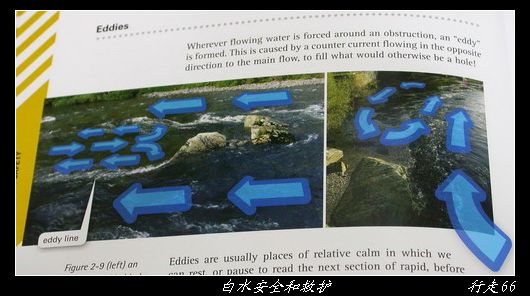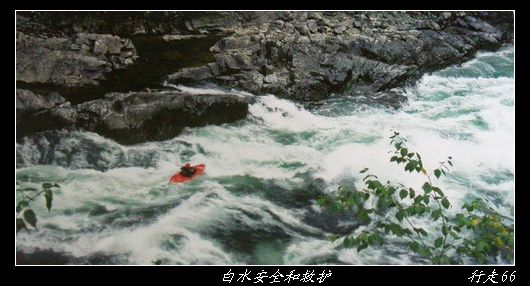

等级:小飞驴
文章:1772
积分:2207
门派:暴走族
注册:Sunday, May 16, 2004 |

Eddies
Wherever flowing water is forced around an obstruction, an "eddy" is formed. This is caused by a counter current flowing in the opposite direction to the main flow, to fill what would otherwise be a hole!
 此主题相关图片如下: 此主题相关图片如下:

Figure 2-9 (left) an eddy formed behind a midstream boulder.
Figure 2-10 (right) an eddy formed by an obstruction on bank
Eddies are usually places of relative calm in which we can rest, or pause to read the next section of rapid, before we commit ourselves to paddling it. We often paddle a river by hopping from one safe eddy to another.This can be visualized by imagining the main flow of the river as a fast moving conveyor belt and the eddies as a series of stable platforms which we can hop on to, in order to rest and get our bearings.
In slow flowing or low volume technical rivers, eddies are usually calm places. In fast flowing, high volume rivers, the counter current can be fast flowing and the water in the eddy fairly turbulent.
In the worst case scenario the recirculating current in an eddy can feed you straight back into the main current, or into a hazard you were trying to advoid.
* Eddy lines--The eddy line or "eddy fence" is a visible line on the surface of the water that marks the border between the main flow and the counter current. Think of it as the point where the edge of the conveyor belt meets the platform. When one aims to eddy-out or eddy-in, at an angle of, say 45°, the angle is between the directiong of travel and the main flow, which is not necessarily the same as the general direction that the river is heading in.
*Eddy zones -- On less powerful rivers the line between the eddy and main current will be quite distinct at the top of the eddy. However, the line will gradually become less distinct and broaden so that it becomes a zone rather than a line.
In very hight volume rivers flows, the whole eddy may be huge and full of swirls and boils. On this type of river it may be better to stay out in the main flow until the rapid loses power and the eddies become calmer. When you go for an eddy, choose where to cross the eddy zone so that you end up in a quiter part of the eddy.
 此主题相关图片如下: 此主题相关图片如下:

Figure2-11 Habretooth Rapid (Grade IV) Clearwater, BC. Note the huge boils in the eddy on river left (top right of photo) |

BLOG: http://hi.baidu.com/walk66 |
|
|

 注册
注册
 搜索
搜索
 风格
风格
 论坛状态
论坛状态
 论坛展区
论坛展区
 我能做什么
我能做什么  注册
注册
 搜索
搜索
 风格
风格
 论坛状态
论坛状态
 论坛展区
论坛展区
 我能做什么
我能做什么  原野论坛 → 原野户外 → 原野无边 → 白水安全和救护(书)
原野论坛 → 原野户外 → 原野无边 → 白水安全和救护(书)





 2/12/2010 11:22:46 AM
2/12/2010 11:22:46 AM

 2/12/2010 11:24:36 AM
2/12/2010 11:24:36 AM

 2/12/2010 11:26:19 AM
2/12/2010 11:26:19 AM

 2/12/2010 11:27:58 AM
2/12/2010 11:27:58 AM